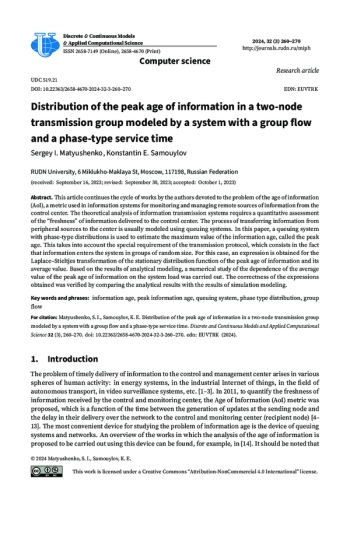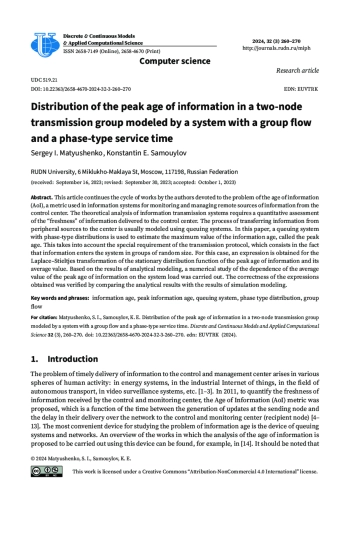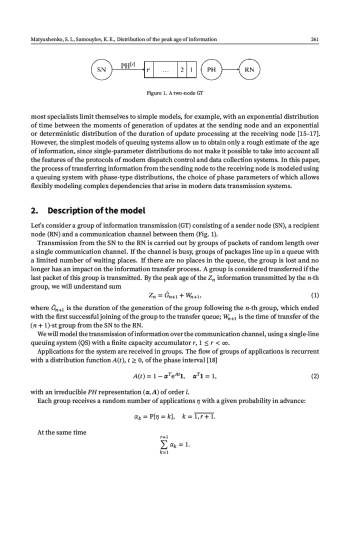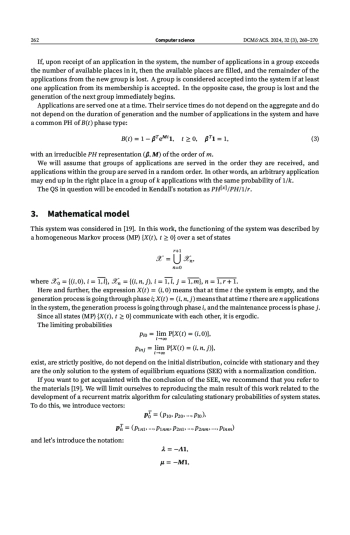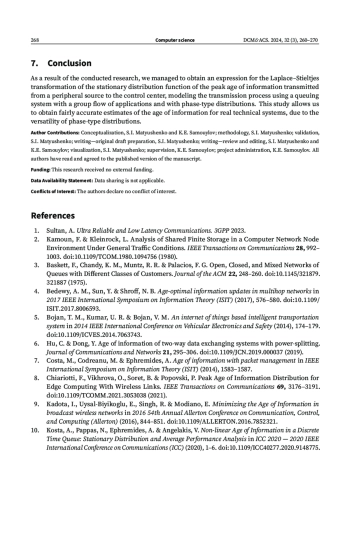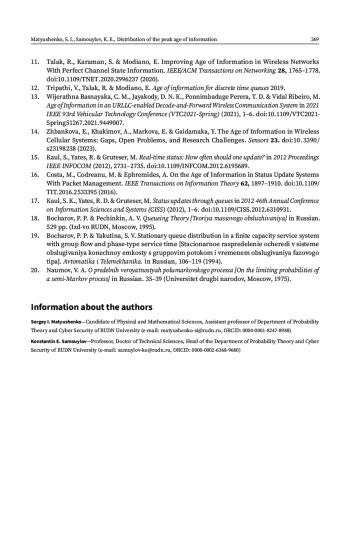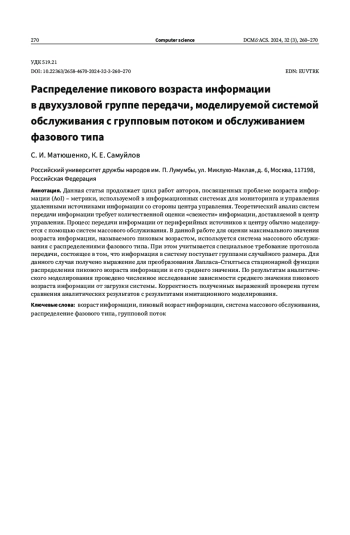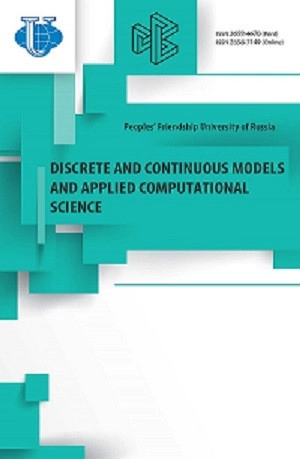This article continues the cycle of works by the authors devoted to the problem of the age of information (AoI), a metric used in information systems for monitoring and managing remote sources of information from the control center. The theoretical analysis of information transmission systems requires a quantitative assessment of the “freshness” of information delivered to the control center. The process of transferring information from peripheral sources to the center is usually modeled using queuing systems. In this paper, a queuing system with phase-type distributions is used to estimate the maximum value of the information age, called the peak age. This takes into account the special requirement of the transmission protocol, which consists in the fact that information enters the system in groups of random size. For this case, an expression is obtained for the Laplace–Stieltjes transformation of the stationary distribution function of the peak age of information and its average value. Based on the results of analytical modeling, a numerical study of the dependence of the average value of the peak age of information on the system load was carried out. The correctness of the expressions obtained was verified by comparing the analytical results with the results of simulation modeling.
Идентификаторы и классификаторы
The problem of timely delivery of information to the control and management center arises in various spheres of human activity: in energy systems, in the industrial Internet of things, in the field of autonomous transport, in video surveillance systems, etc. [1–3]. In 2011, to quantify the freshness of information received by the control and monitoring center, the Age of Information (AoI) metric was proposed, which is a function of the time between the generation of updates at the sending node and the delay in their delivery over the network to the control and monitoring center (recipient node) [4– 13]. The most convenient device for studying the problem of information age is the device of queuing systems and networks.
Список литературы
1. Sultan, A. Ultra Reliable and Low Latency Communications. 3GPP 2023.
2. Kamoun, F. & Kleinrock, L. Analysis of Shared Finite Storage in a Computer Network Node Environment Under General Traffic Conditions. IEEE Transactions on Communications 28, 992– 1003. doi:10.1109/TCOM.1980.1094756 (1980).
3. Baskett, F., Chandy, K. M., Muntz, R. R. & Palacios, F. G. Open, Closed, and Mixed Networks of Queues with Different Classes of Customers. Journal of the ACM 22, 248–260. doi:10.1145/321879. 321887 (1975).
4. Bedewy, A. M., Sun, Y. & Shroff, N. B. Age-optimal information updates in multihop networks in 2017 IEEE International Symposium on Information Theory (ISIT) (2017), 576–580. doi:10.1109/ ISIT.2017.8006593.
5. Bojan, T. M., Kumar, U. R. & Bojan, V. M. An internet of things based intelligent transportation system in 2014 IEEE International Conference on Vehicular Electronics and Safety (2014), 174–179. doi:10.1109/ICVES.2014.7063743.
6. Hu, C. & Dong, Y. Age of information of two-way data exchanging systems with power-splitting. Journal of Communications and Networks 21, 295–306. doi:10.1109/JCN.2019.000037 (2019).
7. Costa, М., Codreanu, М. & Ephremides, А. Age of information with packet management in IEEE International Symposium on Information Theory (ISIT) (2014), 1583–1587.
8. Chiariotti, F., Vikhrova, O., Soret, B. & Popovski, P. Peak Age of Information Distribution for Edge Computing With Wireless Links. IEEE Transactions on Communications 69, 3176–3191. doi:10.1109/TCOMM.2021.3053038 (2021).
9. Kadota, I., Uysal-Biyikoglu, E., Singh, R. & Modiano, E. Minimizing the Age of Information in broadcast wireless networks in 2016 54th Annual Allerton Conference on Communication, Control, and Computing (Allerton) (2016), 844–851. doi:10.1109/ALLERTON.2016.7852321.
10. Kosta, A., Pappas, N., Ephremides, A. & Angelakis, V. Non-linear Age of Information in a Discrete Time Queue: Stationary Distribution and Average Performance Analysis in ICC 2020 — 2020 IEEE International Conference on Communications (ICC) (2020), 1–6. doi:10.1109/ICC40277.2020.9148775.
11. Talak, R., Karaman, S. & Modiano, E. Improving Age of Information in Wireless Networks With Perfect Channel State Information. IEEE/ACM Transactions on Networking 28, 1765–1778. doi:10.1109/TNET.2020.2996237 (2020).
12. Tripathi, V., Talak, R. & Modiano, E. Age of information for discrete time queues 2019.
13. Wijerathna Basnayaka, C. M., Jayakody, D. N. K., Ponnimbaduge Perera, T. D. & Vidal Ribeiro, M. Age of Information in an URLLC-enabled Decode-and-Forward Wireless Communication System in 2021 IEEE 93rd Vehicular Technology Conference (VTC2021-Spring) (2021), 1–6. doi:10.1109/VTC2021- Spring51267.2021.9449007.
14. Zhbankova, E., Khakimov, A., Markova, E. & Gaidamaka, Y. The Age of Information in Wireless Cellular Systems: Gaps, Open Problems, and Research Challenges. Sensors 23. doi:10.3390/ s23198238 (2023).
15. Kaul, S., Yates, R. & Gruteser, M. Real-time status: How often should one update? in 2012 Proceedings IEEE INFOCOM (2012), 2731–2735. doi:10.1109/INFCOM.2012.6195689.
16. Costa, M., Codreanu, M. & Ephremides, A. On the Age of Information in Status Update Systems With Packet Management. IEEE Transactions on Information Theory 62, 1897–1910. doi:10.1109/ TIT.2016.2533395 (2016).
17. Kaul, S. K., Yates, R. D. & Gruteser, M. Status updates through queues in 2012 46th Annual Conference on Information Sciences and Systems (CISS) (2012), 1–6. doi:10.1109/CISS.2012.6310931.
18. Bocharov, P. P. & Pechinkin, A. V. Queueing Theory [Teoriya massovogo obsluzhivaniya] in Russian. 529 pp. (Izd-vo RUDN, Moscow, 1995).
19. Bocharov, P. P. & Yakutina, S. V. Stationary queue distribution in a finite capacity service system with group flow and phase-type service time [Stacionarnoe raspredelenie ocheredi v sisteme obslugivaniya konechnoy emkosty s gruppovim potokom i vremenem obslugivaniya fazovogo tipa]. Avtomatika i Telemekhanika. in Russian, 106–119 (1994).
20. Naumov, V. A. O predelnih veroyatnostyah polumarkovskogo processa [On the limiting probabilities of a semi-Markov process] in Russian. 35–39 (Universitet drugbi narodov, Moscow, 1975).
Выпуск
Другие статьи выпуска
A new method for the correct identification of various complex structural elements of ancient hieroglyphs is described. The method is based on photometry of the studied surface of the ancient artifacts. The obtained data are converted into digital form in order to determine the characteristics and parameters characterizing the properties of the investigated artifact surface. Digitized data is processed in various graphic applications, including those working with vector images. Several control experiments were also carried out. In particular, the corresponding statistical characteristics and parameters of the studied artifact surface profiles were determined. The data obtained made it possible to unambiguously detect the ancient hieroglyphs on the artifact surface and determine their number. Described method of studying ancient artifacts makes it possible to obtain sufficiently reliable results that will undoubtedly be useful and promising in the study of ancient hieroglyphic signs. Our research method is characterized as: non-contact, informative, and sensitive. This testifies to its importance and prospects in the study of similar ancient artifacts.
The filtration process is studied for a popular class of filters with radial cartridges that proved their high effectiveness in purification of water. The mass balance equation for radial flows in porous media is obtained by using the lattice approximation method, the transverse diffusion process being taken into account. The Euler dynamical equations are modified by including the Darcy force proportional to the velocity of the filtration flow. The system of equations is written for the stationary axially symmetric radial flow and solved by the perturbation method, if the vertical velocity is supposed to be small.
Our group has been investigating kinetic models for quite a long time. The structure of classical kinetic models is described by rather simple assumptions about the interaction of the entities under study. Also, the construction of kinetic equations (both stochastic and deterministic) is based on simple sequential steps. However, in each step, the researcher must manipulate a large number of elements. And once the differential equations are obtained, the problem of solving or investigating them arises. The use of symbolic-numeric approach methodology is naturally directed. When the input is an information model of the system under study, represented in some diagrammatic form. And as a result, we obtain systems of differential equations (preferably, in all possible variants). Then, as part of this process, we can investigate the resulting equations (by a variety of methods). We have previously taken several steps in this direction, but we found the results somewhat unsatisfactory. At the moment we have settled on the package Catalyst. jl, which belongs to the Julia language ecosystem. The authors of the package declare its relevance to the field of chemical kinetics. Whether it is possible to study more complex systems with this package, we cannot say. Therefore, we decided to investigate the possibility of using this package for our models to begin with standard problems of chemical kinetics. As a result, we can summarize that this package seems to us to be the best solution for the symbolic-numerical study of chemical kinetics problems.
Currently, an increasing number of fiber-optic communication lines are reaching the end of their predetermined service life, yet the quality indicators of these lines still allow for continued operation. To extend the actual operational life of these lines, it is necessary to conduct high-quality monitoring of both the current status of all components and the dynamics of key indicators. This article proposes a method for addressing the challenge of maintaining communication network reliability while continuing to use optical cables after their warranty period has expired. A study of random values of the attenuation coefficient and polarization mode dispersion of an optical fiber, supported by actual operational data from a network segment, shows high temporal stability in the attenuation coefficient and polarization mode dispersion of optical fiber type G.652. This conclusion allows us to discuss the continued operation of optical cables after the warranty period. To analyze the key aging metric, mathematical models are used that take into account the physical and chemical properties of cables as well as the conditions of their proof-tests. Using an example related to the current state of Russian fiber optic networks, we calculate the number of emergency reserve elements necessary to maintain the reliability of their operation. Practical recommendations for the placement of emergency reserve are also provided.
Chronic non-communicable diseases account for more than 70% of global mortality statistics. The main share is made up of diseases of the cardiovascular system. Adequate preventive measures—impact on controllable and conditionally controllable risk factors—can reduce the contribution of these diseases to the structure of mortality. A significant effect can be achieved with an adequately selected level of physical activity, but doctors do not always recommend specific actions to patients. This article describes a prototype of a cognitive assistant for constructing personalized plans for therapeutic physical exercises for relatively healthy people and people suffering from cardiovascular diseases. The developed system consists of two main components: a cardiovascular risk assessment module and an exercise planning module. The risk assessment module consists of a knowledge base and an argumentative reasoning algorithm. Its task is to identify risk factors and levels, which is dual in nature: in the case of monitoring a relatively healthy user, the risk of developing cardiovascular disease is assessed, while in the case of interaction of the system with a user with cardiovascular disease, the risk of complications of a chronic form is assessed—development of a cardiovascular event. The exercise planning module includes an exercise database and a scheduler algorithm. The planning algorithm selects optimal therapeutic physical exercises according to optimal criteria, in order to form a plan that will not harm the patient and will increase his physical performance. The developed mechanism allows you to create training scenarios for users with any level of initial training, taking into account the available sports equipment, the preferred location for training (home, street, gym) and at any level of the cardiovascular continuum.
In this paper, we study a queuing system with a single-capacity storage device and queue updating. An update is understood as the following mechanism: an application that enters the system and finds another application in the drive destroys it, taking its place in the drive. It should be noted that systems with one or another update mechanism have long attracted the attention of researchers, since they have important applied significance. Recently, interest in systems of this kind has grown in connection with the tasks of assessing and managing the age of information. A system with a queue update mechanism similar to the one we are considering has already been studied earlier in the works of other authors. However, in these works we were talking about the simplest version of the system with Poisson flow and exponential maintenance. In this paper, we consider a phase-type flow and maintenance system. As a result of our research, we developed a recurrent matrix algorithm for calculating the stationary distribution of states of a Markov process describing the stochastic behavior of the system in question, and obtained expressions for the main indicators of its performance.
We describe introduced in the journal the rubric system.
Статистика статьи
Статистика просмотров за 2025 год.
Издательство
- Издательство
- РУДН
- Регион
- Россия, Москва
- Почтовый адрес
- 117198, г. Москва, ул. Миклухо-Маклая, д. 6
- Юр. адрес
- 117198, г Москва, Обручевский р-н, ул Миклухо-Маклая, д 6
- ФИО
- Ястребов Олег Александрович (РЕКТОР)
- E-mail адрес
- rector@rudn.ru
- Контактный телефон
- +7 (495) 4347027
- Сайт
- https://www.rudn.ru/
